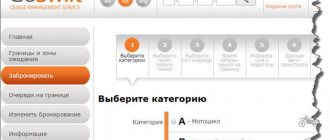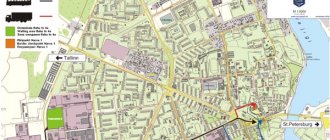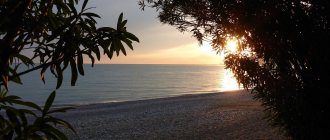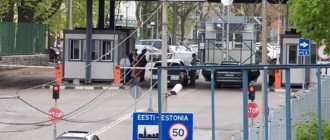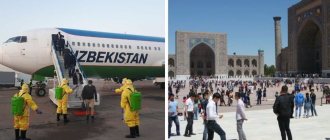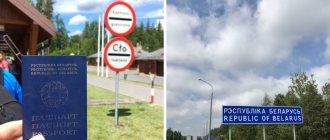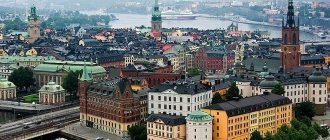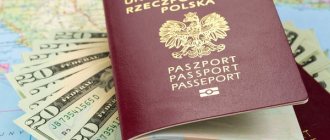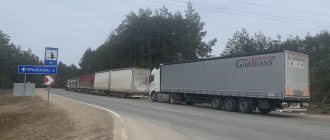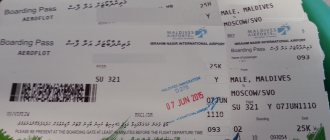Documents required to cross the Russian-Estonian border by car
To cross the Russian-Estonian border in your car, you must present the following minimum package of documents at the border crossing point:
1. A foreign passport valid for at least six months after the planned return from Estonia.
2. Valid Schengen visa. Estonian Schengen can be obtained from the Estonian Embassy in Moscow (Maly Kislovsky lane, 5, www.estemb.ru, e-mail :
), in the consular departments of Estonia in
St. Petersburg (Bolshaya Monetnaya, no. 14, www.peterburg.estemb.ru, e-mail :
) and
Pskov (Narodnaya, no. 25, e-mail: [email protected] ).
In order to enter Estonia, it is absolutely not necessary to present an Estonian visa to the border guards - a multi-Schengen visa from any country that is part of the Schengen agreement is also suitable. Moreover, if, for example, you received a multi-Schengen visa at the French Embassy, there is absolutely no point in trying to first go to France, and only then to other European countries. Absolutely legally, with such a visa you can go first, for example, to Estonia or somewhere else, and only then to France. In this case, the main thing is that you have at least one French stamp on this visa, confirming that you were in France after all and it was not for nothing that they issued you their visa. 3. If you are traveling with children, you will need to present the child’s birth certificate at the Russian-Estonian border. If a child is traveling without one of the parents, a notarized power of attorney will be needed for the responsible person to have the right to travel with the child outside the Russian Federation.
4. International vehicle insurance (the so-called “green card”). You can purchase it from most large insurance companies; for a period of 14 days for a passenger car it will cost about 2,500 rubles (for the summer of 2021). By the way, if you forgot to purchase a “green card” before your trip, you can do this already at the entrance to the border: just look carefully around, the closer you are to the checkpoint, the more often you will come across kiosks with signs “insurance”, “Schengen insurance” and the like. The only downside in this case will be that you will have to choose from the list of companies with which these cross-border insurance brokers cooperate.
5. Medical insurance with insurance coverage of at least 30 thousand euros is the standard insurance required to obtain a Schengen visa from any of the countries included in the agreement. At the border, people often don’t ask for medical insurance, but according to the rules they must do so - so it is very advisable to have it with you.
6. International driving license and national driving license. MVO at the border is also often not required, but since Estonia has signed the Convention on Road Traffic, they may well do so. Obtaining an international driver's license is not difficult: to do this, you just need to obtain the necessary medical certificates, take photographs, contact the authorized MREO at your place of residence, fill out an application and pay the state fee; Unlike the national driving license, the MVO is issued for a period of 3 years (but its validity cannot exceed the validity of your national license).
Electronic queue
Estonians introduced an electronic queue back in 2011. The Russian service only started using it in 2012. The system is called GoSwift. This queue exists along with the usual one, and does not mean that you will not have to stand in a long row of cars. It’s just that entry and exit in this case will be faster and more organized.
Everyone who has not signed up for the electronic queue will go through the usual quota, after those who have secured a reservation for crossing the border with Estonia.
Thanks to the virtual queue, the entire process of entering the Estonian state will not take more than half an hour. You can make a reservation in three ways:
- In telephone mode.
- In the waiting area in Narva.
- Online at www.eee or www.estonianBorder.eu (for leaving the country).
The easiest way is online mode. To cross the border from Russia you need to use the www.goswift.ru service.
The procedure looks like this:
- choose the type of car you are driving;
- choose the point where you intend to cross the border;
- determine the day of entry;
- Having considered the free time intervals, set the time for crossing the border.
Requirements for a car when crossing the border between Russia and Estonia
First of all, the car must be technically sound and have readable license plates in accordance with legal requirements. Also, border guards often pay attention to the condition of the glass and headlights: the glass should not have cracks (at least the windshield in the driver’s line of sight) - Poles and, to a lesser extent, Finns are considered especially scrupulous in this matter. For the Balts, I didn’t notice any particular desire to find fault with the condition of the car, but it’s still better to put it in order before the trip. EU border officials have a very negative attitude towards any “radar detectors” and “video recorders” - so it is better to keep them away while crossing the border. As for the age of the car: there are no restrictions on age (unlike, for example, Azerbaijan) and environmental friendliness of the exhaust on the Russian-Estonian border, the main thing is that black smoke does not come out of the exhaust pipe. In exceptional cases, border crossing staff can check the CO content in the exhaust - but I have never encountered this. Regarding the additional equipment required to cross the border between Russia and Estonia: as far as I know, there is no clear list and the opinions of “experienced” people vary greatly, so I will give my version, formed after numerous trips by car to the countries of the European Union and Transcaucasia. Some of this list may seem superfluous to the reader, but there is always a possibility that some particularly zealous employee will decide to get to the bottom of something you are missing and thus ruin the start of your long-awaited vacation.
List of additional vehicle equipment for crossing the Russian-Estonian border:
Fire extinguisher RUS sticker on the trunk lid First aid kit according to TUV standards Warning triangle Tow rope Reflective vest Not necessary, but highly recommended on a long journey: A full set of tools for minor repairs Full-size spare tire Metal canister for fuel Pump Wheel wrench Jack Wire for “lighting” Wheel chocks shoes” – 2 pcs. (regarding the “shoes” - I came across information on the Internet that Estonian border guards check for them when crossing the border. I won’t lie, I’ve never been asked - but I take them with me just in case).
Crossing the border as usual
If you are planning to travel from Russia to Estonia by bus, train, ferry or plane, then you will probably contact either a travel agency or a visa center. You can, of course, book tickets and hotel rooms yourself. It is even easier to cross the border if you are invited to visit relatives living in the EU. One way or another, to make such a trip, you don’t need to delve into the intricacies, the main thing is to have the following documents with you:
- foreign passport (at least two blank pages, valid for at least three months from the end of the planned trip);
- open national or Schengen visa;
- valid health insurance policy.
One way or another, there will be no problems showing documents at the port, airport or train station. The only exception is citizens who are subject to a ban on leaving the Russian Federation.
To assess the likelihood of a ban on flying abroad and find out information about the presence of debt on loans, fines, alimony, housing and communal services, etc., we recommend reading our article.
But if you travel to Estonia with your own vehicle, things become much more complicated. You need to prepare additional documents, get your car or motorcycle in proper condition, choose the least crowded route, monitoring the situation at the Estonian border online or with the help of friends. However, if you don’t worry, correctly draw up an action plan and follow it, you will get to your destination on time.
Where to queue at the Estonian border
Border points are few. If you plan to travel by car from Russia rather than transit through Latvia, there are three places available to you where you can “talk” with immigration officers. For convenience, checkpoints on the border with Estonia are presented in the form of a table below.
| Item name | Distance from Moscow | Distance from St. Petersburg | Throughput (persons per 24 hours) | Basic information |
| Ivangorod–Narva | 780 km | 120 km | 7 000 | Address: Leningrad region, Ivangorod, Kingiseppskoe highway, 8. The nearest gas stations are Neste, Lukoil. |
| Kunichina Gora–Koidula | 730 km | 330 km | 2 000 | Address: Pskov region, Pechora district, village. Kunichina Mountain. The nearest gas stations are Surgutneftegaz, Lukoil. |
| Shumilkino–Luhamaa | 730 km | 340 km | 4 000 | Address: Pskov region, Pechora district, Panikovskaya Volost, village. Shumilkino. The nearest gas stations are Surgutneftegaz, PTK, Aris. |
Each of the above points operates around the clock, 365 days a year. Shopping enthusiasts will be delighted to find Duty Free shops and Tax Free return systems at the border. Drivers of large vehicles will not be offended either: each point is considered a cargo-passenger point.
Excitement ahead of the New Year holidays
Registration at the border with Estonia for motorists usually takes little time, but there is one exception: the New Year holidays are a time of rush among tourists, as well as relatives of people living in EU countries. As a result, the queue can stretch for 8 hours or even more - and this is in normal mode: periodically people encounter emergencies and spend almost half the day at the border. Thus, in the winter of 2021, one of the checkpoints required emergency repairs: travelers are still discussing this event on Russian forums. In addition to the New Year holidays, the time of accumulation of Russian cars and buses at the border is:
- May holidays (May 1–10);
- November holidays (November 1–4);
- last week of summer.
Long lines to enter begin to form at 8 a.m., with cars piling up until noon. As for the queue to leave Estonia for Russia, the heaviest hours on such days are from 14:00 to 18:00. But this does not mean that the long-awaited trip should be postponed! There are several ways to reduce the wait:
- watch the online broadcast from surveillance cameras installed at the border and, depending on what you see, adjust the route;
- read comments from travelers on the Border Online website and ask questions about the situation at a specific checkpoint;
- use toll roads;
- reserve your place in line online.
If you join the electronic queue, please note that you need to register on the site at least three hours in advance. It is better to take plenty of time, since it will take the immigration officers 15 minutes just to fill out the application. However, first things first.
Crossing the border and reserving a place in line
The electronic queue at the Estonian border is available to absolutely all guests who are going back to Russia. But booking an entry space is currently only available to those who want to enter Estonia through the Kunichina Gora-Koidula checkpoint. You can register online, as already mentioned, no less than three hours before your appearance, but you don’t have to worry about the upper limit. Book your pass at least a month in advance! This is especially true for those who are going to Estonia for the holidays - electronic coupons can be “disassembled” three weeks before the chosen date.
To reserve a place in the queue to cross the border from Russia to Estonia, you need to go to the GoSwift electronic queue system, https://www.eestipiir.ee, select a date and set your time, and then pay for the service. Fortunately, booking a time is not the most expensive pleasure. Even owners of category D trucks pay no more than 14 € for a pass.
Additional information for car owners
As we have already found out, crossing the Russia-Estonia border by car is not easy for Russians. In addition to the aspects listed above (how to join the electronic queue, what documents to prepare), a person who is going to drive a car needs to understand some nuances. Before leaving Russia, make sure you have:
- international law;
- technical passport of the vehicle;
- a document confirming that the car or motorcycle is your property;
- international compulsory vehicle insurance policy - the so-called “green card”.
What a “green card” is is worth telling in more detail. We are talking, as you might guess, not about a visa to America, but about a special document that will be useful in the event of an accident at the border. You can take out this policy right at the border (insurance companies are located not far from the checkpoint). But it’s better to play it safe and sort out the formalities in advance by contacting your “native” office in your own city. This way you will save:
- time - queues do not always line up, and you will be forced to spend at least 20 minutes applying for a policy instead of driving through immediately;
- money - border insurance companies provide services at inflated prices;
- nerves - you must admit, it’s much more pleasant to go abroad knowing that you have already completed all the formalities.
Another subtlety concerns those who “changed” their car to studded tires. When traveling to Estonia in this form, make sure that it is officially permitted by the Estonian Road Administration https://www.mnt.ee/ru. Usually, from November to March, problems with winter tires do not arise, and yet the timing is negotiated separately each time.
Where to cross the border between Russia and Estonia
At the moment, three land border crossing points between Russia and Estonia are open: “Ivangorod - Narva” , “Kunichina Gora - Koidula” , “Shumilkino - Luhamaa” . Let's take a closer look at them.
The main and, importantly, the busiest checkpoint is considered to be the Ivangorod-Narva ; travelers from St. Petersburg and the Russian North-West in general, as well as Muscovites who want to get to Tallinn along the shortest possible route, usually travel through it to Estonia.
The checkpoint on the Russian-Estonian border “Shumilkino - Luhamaa” is mainly preferred by those who: a) are traveling to South Estonia b) are traveling to Tallinn or the islands of Hiiumaa and Saaremaa, but want to avoid standing in hours-long traffic jams at the border and c) are traveling in transit through the territory of Estonia to Latvia and generally to the southern Baltic.
In terms of workload, the point “Ivangorod - Narva” is followed by “Shumilkino - Luhamaa” , and the third is “Kunichina Gora - Koidula” . For example, in July 2021, the situation with queues (for cars) on the Russian-Estonian border was as follows: “Ivangorod - Narva”: 5 hours or more “Kunichina Gora - Koidula”: 1 hour “Shumilkino - Luhamaa”: 2 hours
All three Estonian-Russian border crossing points operate 24 hours a day.
Checkpoint on the border with Estonia
Top
Online parking camera near the border with Estonia from Narva
You can enter Estonia through three checkpoints: the Shumilkino/Lukhamaa checkpoint and the Kunichina Gora/Koidula checkpoint in the Pskov region, and the Ivangorod/Narva checkpoint in the Leningrad region.
At all three checkpoints, motorists, pedestrians and cyclists can cross the border into Estonia.
Ivangorod/Narva checkpoint
The largest checkpoint on the border between Russia and Estonia, its capacity is up to 1,800 vehicles per day (about 7,000 people). Crossing the border here, you find yourself in Narva, from where you can continue your journey in any direction.
At the moment, work is underway on the territory of the Narva checkpoint to reorganize the customs point - a new terminal is being built. In the future, this will significantly increase the speed of crossing the border with Estonia; For now, all traffic goes through the truck terminal.
From May 23, 2021, when reserving a place in the queue for vehicles of categories A and B at the Narva border point, the following changes will apply:
- When reserving a place in the queue for a specific time, you need to pay 1.50 € for the reservation and for the waiting area in accordance with the category of the vehicle (category A - 1 €, category B - 3 €). Category B vehicles are given 20 minutes to travel from the waiting area to the border checkpoint.
- A place in the queue at the Narva border checkpoint can be reserved free of charge only if the vehicle is registered in the live queue at the self-service kiosk located directly in the Narva waiting area. In this case , the vehicle must remain in the waiting area for no more than 15 minutes (the vehicle receives a call to the border and leaves the waiting area immediately after registration).
Opening hours : around the clock Address : 188454, Leningrad region, Ivangorod, Kingiseppskoe highway, 8 Distance from St. Petersburg/Moscow : 120 km/780 km Phone : (81375) 5-29-78 Coordinates : 59.3666648, 28.2166671 Duty Free store : “CAPO Duty-Free” (24 hours; technical break from 8.30 to 9.00 and from 20.30 to 21.00) Tax Free returns : 24 hours
Kunichina Gora/Koidula checkpoint
At this checkpoint, a queue reservation system was introduced for the first time on the border with Estonia - here you need to select in advance not only the time of departure from Estonia, but also the time of crossing the border from Russia. This is done in the same way as in the case of departure.
Opening hours : around the clock Address : 181500 Pskov region, Pechora district, village. Kunichina Gora Distance from St. Petersburg/Moscow : 330 km/730 km Phone : (81148) 9-34-27 Coordinates : 59.866883, 29.223633 Duty Free store : “CAPO Duty-Free” (24 hours) Tax Free returns : 24 hours a day
Shumilkino/Luhamaa checkpoint
If you plan to travel through this checkpoint, do not be afraid of queues at the border with Estonia: few people use this checkpoint, and besides, there is a separate corridor for cars with Russian license plates.
Opening hours : around the clock, break from 13.00 to 14.00, shift changes from 9.00 to 9.30 and from 21.00 to 21.30 Address : 181512 Pskov region, Pechora district, Panikovskaya Volost, Shumilkino village Distance from St. Petersburg/Moscow : 340 km/ 730 km Phone : (81148) 9-33-23 Coordinates : 59.578851, 29.223633 Duty Free store : “CAPO Duty-Free” (24 hours) Tax Free returns : 24 hours
How to get to checkpoints across the Russian-Estonian border
International checkpoint “Ivangorod – Narva”
Russian-Estonian border, checkpoint “Ivangorod - Narva”
Address: Narva, Westervalli 3 (Tallinn-Narvat Highway) 20307, Telephone: +372 6123000 How to get there: You can get from St. Petersburg to Ivangorod along the Narva highway in about two hours.
International checkpoint “Shumilkino – Luhamaa”
Russian-Estonian border, checkpoint "Shumilkino - Luhamaa"
Address: Võru district, Lüta Misso vald (Highway Riga-Pskov) 65011, phone: +372 6123000 How to get there: From Pskov to Shumilkino you can take the E77 (A212) Pskov – Riga highway. GPS coordinates of the checkpoint “Shumilkino – Luhamaa”: N57°38.708′; E27°23.451′
International checkpoint “Kunichina Gora – Koidula”
Russian-Estonian border, checkpoint “Kunichina Gora - Koidula”
Address: Koidula, Värska vald (Karisilla-Pechorskoe highway) 64003, Phone: +372 6123000 How to get there: From Pskov on the E77 road (A212) you need to get to Izborsk and turn right at the sign for Pechory. There will be a toll section of the road between Izborsk and the border, the fare will be 150 rubles.
The procedure for crossing the border between Russia and Estonia
Russian-Estonian border at the Ivangorod-Narva checkpoint
The border between Russia and Estonia passes along the Friendship Bridge . When moving from Russia, border crossing takes place on a first-come, first-served basis; when moving from Estonia, by prior online registration or also on a first-come, first-served basis.
Advice: when moving to Estonia, before crossing the border, fill up with fuel “to capacity” and pour gasoline into a canister (if available) - fuel in Estonia (and in general in the Baltic states) costs 1.05-1.1 euros per liter, which is as for the summer of 2016, approximately twice as expensive as in Russia. For example, I refueled in Shumilkino and then drove all over Estonia and Latvia on Russian gasoline; I had to refuel for euros only at the entrance to Vilnius, Lithuania. Border guards and customs officers, by the way, do not show the slightest interest in gasoline in cans: I was carrying 20 liters, although according to EU rules you can import no more than 10 liters of gasoline for personal use.
On the Russian side, when crossing the border, you will need to present a foreign passport with a valid visa and a registration certificate for the car, as well as, at the request of the checkpoint employees, any document from the list given in the first part of this article. In addition, it will be necessary to ensure that the vehicle and (if necessary) luggage are inspected.
On the Estonian side, the control will be more thorough: you will also have to present all the mentioned documents (passports with visas, registration certificate for the car, medical insurance for the driver and passengers, “green card” for the car, national driver’s license and MBO). In addition to checking documents, checkpoint employees on the Estonian side must perform a visual inspection of the car: to do this, you will need to get out of the car, open all the doors and the trunk lid, glove compartment and lift the hood. If questions arise, you may be asked to open your luggage. If everything is in order, the employee will write down the VIN number of your car and, after you receive a stamp confirming that you have crossed the border of the European Union, will give you the go-ahead to enter Estonia. Immediately after the Russian-Estonian border you will arrive in the city of Narva, where you can rest and refresh yourself before the further journey.
Border between Russia and Estonia at the Shumilkino – Luhamaa checkpoint
The Russian-Estonian border crossing point "Shumilkino - Luhamaa" is equipped with four vehicle control posts, its estimated capacity is 4,000 people per day, it is the second busiest after the "Ivangorod-Narva" . to the Shumilkino from Pskov along the Pskov-Riga highway, the point is located about 40 km from Pskov - the road is free and recently repaired. The procedure for crossing the border is generally similar to that given in the section “Ivangorod-Narva” ; cars are sent to two different queues - one for cars with Russian license plates, the second with foreign ones. At the control point itself there are two booths (Russian border guards proudly call them “pavilions”): the first is passport control, the second is customs. As I already mentioned, during the inspection, the Estonians were not at all interested in the 20-liter canister of gasoline in my trunk, although according to the rules, the import of only 10 liters of gasoline for personal use is allowed. In general, in my personal impression, at the border no one will bother you for no reason, you just need to have all your documents in order and be polite and friendly with customs officers and border guards.
The queue at the Shumilkino – Luhamaa checkpoint: when I arrived at the Russian checkpoint, there were exactly ten cars in line in front of me, the total time of my border crossing was about an hour and a half. At the border it occurred to me that the legendary slowness of Estonians is not a myth :-) Or rather, not slowness, but a certain, let’s say, sedateness in thoughts and movements.
Immediately after the Russian-Estonian border on the Estonian side there is a good and inexpensive cafe - after the checkpoint you need to turn left into the parking lot. Russian-Estonian border at the Kunichina Gora – Koidula checkpoint
The Kunichina Gora – Koidula checkpoint is currently the only one of the three where you can pre-book a border crossing time when moving from Russia to Estonia (this can be done on the website www.goswift.ru).
UPDATE December 2021: as of December 30, 2018, the goswift.ru website does not work and, accordingly, the border is passed on a first-come, first-served basis without prior reservation of time.
As in the points “Ivangorod - Narva” and “Shumilkino - Luhamaa” , you can travel through “ Kunichina Gora” not only by motor vehicles, but also by bicycle or on foot. “Kunichina Gora” point from Pskov you will have to take a toll road (the fare is 150 rubles). The estimated daily capacity of the Kunichina Gora – Koidula is 2000 people. The procedure for crossing the Russian-Estonian border at the Kunichina Gora the Ivangorod-Narva checkpoint : the same document check, control of the vehicle with the opening of all doors, trunk and glove compartment lids, as well as lifting the hood and recording the vehicle's VIN number.
There is a duty-free shop on the territory of the checkpoint. Since border crossing takes place by appointment, cars do not wait their turn in a traditional line one after another, but in a special area, which is a large parking area. The number of the vehicle called to cross the border is displayed on the large screen and the car goes to border control. Parking is located next to the building, where you can sit in a cafe, as well as use the toilet and shower.
Passing the border in Narva
Those who have previously reserved a border crossing time are required to arrive at the Waiting Area at least 15 minutes before the reserved time.
Having approached the barrier, the driver is obliged to stop the car, the recognition system will record the number and automatically open passage to the waiting area. Check-in is possible along one of the open paths.
The waiting area
Citizens crossing the border through the Narva checkpoint are required to arrive at the Waiting Area located at the address: st. Rakhva, 4a. This place is a parking lot located very close to the border. In the Waiting Area, vehicles whose drivers have pre-booked a checkpoint crossing time via the Internet or by phone are checked. There are self-service terminals for reserving border crossing times.
A digital display has been installed in the Waiting Area. It displays information about the license plate numbers of cars whose turn has arrived. After this, the driver moves to the exit, where he pays for the services and presents documents to the operator. After checking and issuing a ticket, the car can be directed to the Narva checkpoint.
Fee for using the waiting area in Narva
The cost of staying in the Waiting Area depends on the type of vehicle. For vehicles belonging to the category:
- "A" fee is 1 euro;
- “B” – 3 euros;
- “C” and “D” – 14 euros.
You can while away the waiting time not only in the car, but also use the rest room or visit a cafe. All these services are provided for a fee.
Peculiarities
Drivers who have booked a queue online or by phone must enter the Waiting Area and remain there until they see their number on the digital display.
If the vehicle stays in the Waiting Area for less than 15 minutes, no fee will be charged upon departure. The ticket received from the waiting area operator must be retained as it must be presented to border control officers.
When booking a time in advance, drivers should take into account the specifics of the checkpoint: at 9 am and at 21:00 there is a shift change at the border and crossing the border is slowed down.
Possibility of privileged crossing of the Russian-Estonian border
In general, crossing the border between Russia and Estonia at all three points occurs on a first-come, first-served basis or by appointment. However, in exceptional cases, you can cross the Russian-Estonian border in a privileged manner (and for this there is absolutely no need to brazenly jump in line, as was recently the custom among Caucasians when crossing the Russian-Georgian border at the Verkhniy Lars checkpoint). At the Russian-Estonian border, everything is reasonable and clearly regulated - the right to skip the border has the right to: - persons with serious health problems with a valid certificate - persons whose visa is expiring - persons who need to attend a funeral - persons who have the need catch a train or plane - persons who have a seriously ill relative - and all of the above must be confirmed by relevant official documents.
In addition, the following have the right to privileged crossing of the Russian-Estonian border: - employees of diplomatic missions and persons accompanying them - members of international delegations and representatives of consular services - vehicles transporting perishable goods - vehicles whose drivers have the right of privileged border crossing on the basis of international treaties and agreements - motorcycles of categories A and A1.
Queue reservation at the Estonian border Narva - Ivangorod
Many tourists perceive the queue booking service as something extra and do not take it seriously. But, thanks to the ability to reserve time in advance, you can significantly shorten the waiting process and speed up border crossing. Cars standing in a live queue move quite slowly and the wait can last up to 2 hours, and according to reservations, crossing the checkpoint does not take more than 30 minutes.
How can I book a queue - registration options
Russians can reserve time in advance to cross the border in several ways:
- via the Internet;
- at self-service kiosks located in the waiting area - Transservice-N parking. It is located at: st. Rahu, 4a;
- by calling the number: +372 (6) 98-91-92.
The fastest way is to book on the website.
Official website for online registration
Tourists can reserve time on the GoSwift website by following the link: www.estonianborder.eu. This is a fairly easy process that does not take much time and does not require special skills and knowledge. The sequence of actions consists of several stages:
- Enter the “Reserve” option.
- Select the desired type of vehicle.
- Select the required checkpoint.
- Activate the “Advance reserve” option.
- Decide on the date and time.
- Enter the required data into the form.
- Pay for your reservation by credit card.
Pre-registration is possible 3 hours before the desired time, but it is better to book a queue several days in advance. The time and date can be changed several times - a maximum of 3. This service is free.
Price
To reserve a queue at the Estonian border you need to pay 1.5 euros. Payment is made by credit card using the specified bank details.
